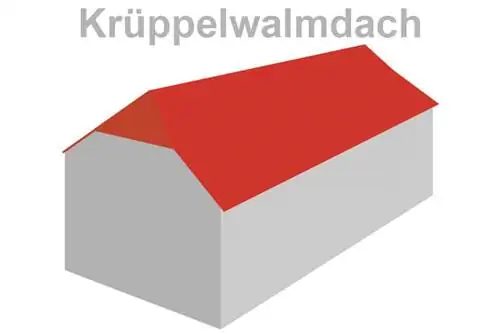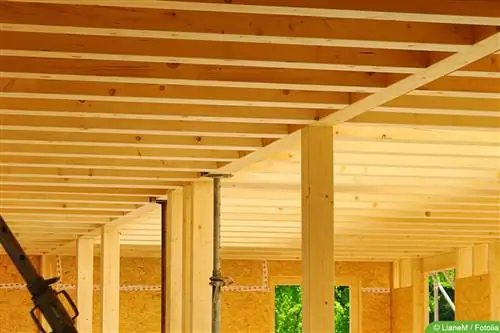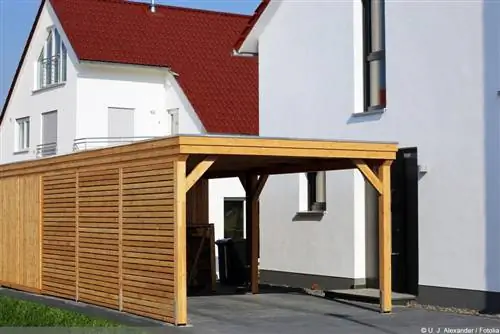- Author admin [email protected].
- Public 2023-12-17 03:39.
- Last modified 2025-01-24 12:45.
Almost everyone knows the typical cut-off gable view of a half-hip roof. She usually ducks under an overhanging roof for protection. However, very few people know that this is a hipped roof. Here you can find out all the information about this traditional roof shape and also learn about numerous advantages and disadvantages.
What is hidden behind the hipped roof?
The hipped roof is a sub-form of the hipped roof. Like this, a hipped roof has two large roof surfaces with identical inclinations that meet in a ridge. The gable ends are also bordered by sloping roof surfaces that meet the centrally arranged ridge. In contrast to the hipped surfaces of the classic hipped roof, which extend up to the eaves, the hipped surfaces of the half-hipped roof are shortened towards the bottom. The eaves, i.e. the lower edge of the roof, project upwards in the gable area. As a result, the triangular gable roof gables are not completely replaced by roof surfaces, as is the case with hipped roofs, but appear here as trapezoids cut off at the top. You could say that the half-hipped roof represents a kind of intermediate step between a gable roof and a hipped roof.
Classic examples of hipped roofs
The prime example of a half-hipped roof is probably the traditional Black Forest farm. The expansive roof covers utility and living spaces at the same time and, thanks to the steep roof pitches, safely drains the sometimes enormous winter snow masses. The large roof overhang ensures that there is a work area in front of the house that is protected from rain and snow. And this is exactly where the hour of the half-hip roof strikes. While a normal hipped roof would result in enormous shading of the entire gable wall, the reduced hipped area ensures sufficient lighting opportunities without reducing the protection of the roof overhang too much.
Construction and statics
The supporting structure of the half-hipped roof is composed of the following main structural elements:
- Roof rafters as a support layer for roof covering
- First as the upper support point of the rafters
- Center purlin or center purlins as support points for the rafters in the middle of the field
- Threshold as the lower support point of the rafters
- Supports or support system (“lying chair” or “standing chair”) for transferring the load from the ridge, purlins and threshold to the solid walls below
ATTENTION:
Unlike the hipped roof, in which all the elements supporting the rafters can be designed to run continuously on all sides, at least the threshold as the lower support point makes a jump in height. In most cases, the threshold on the crooked hip surfaces is completely eliminated, so that the rafters there only rest on the purlins and the hip rafters between the orthogonally aligned roof surfaces.
The roof structure
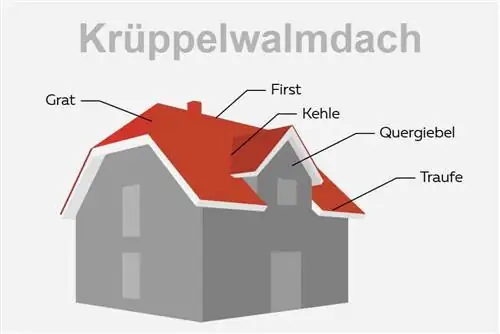
The construction of the historic half-hipped roofs was incredibly simple. As pure weather protection over the unheated roof space, crosswise slats supported the roofing directly on the rafters. Today, however, the roof structure is much more complex (structure from the inside out):
- Optical cladding, e.g. as wooden formwork or plasterboard cladding with paint, wallpaper or plaster
- Support battens for cladding, usually also an installation level for lighting etc.
- Vapor diffusion-tight layer, usually as a foil material
- Construction level made of rafters and soft insulation installed between the rafters (mineral wool, cellulose, etc.)
- Rainproof under-roof membrane, as a foil or additional water-conducting insulation layer (e.g. soft wood fiber board)
- Substructure of the roof covering, in the case of tiles or roof tiles made of counter battens and battens
- Roof covering
NOTE:
If rafters are to remain visually visible in the interior, it is also possible to provide the insulation level either as pressure-resistant polystyrene insulation or as soft insulation between bearing timbers on the rafter level. However, this solution is usually only used in the case of hipped roofs as part of subsequent insulation, as the effort required to create corners between the hipped roof surface and the normal roof surface is structurally complex and therefore expensive to implement.
Common roof coverings
Due to the generally quite high roof pitch of a half-hip roof, the common deck coverings that are also used for a gable roof are usually used for covering:
- Brick
- Concrete roof tiles
- Sheet metal
Regionally motivated, these types of surfaces can also be found again and again as a historical reference and a return to tried and tested things:
- Shingles
- Slate
- Reet / Straw
Roofing made of foil or bituminized membranes, as well as green and gravel roofs, are technically possible, especially for shallower sloping roofs, but when you look at the examples that have been built, they are more of a theoretical nature.
NOTE:
Depending on the roof covering chosen, the required substructure can of course vary. Sheet metal roofing in particular generally requires a flat support in the form of wooden formwork.
The roof pitch of a half-hipped roof
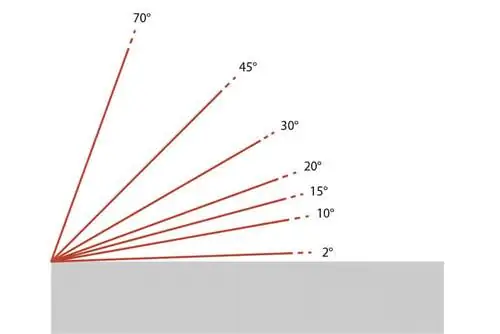
In theory, the hipped roof can be produced with almost any inclination of the main and hipped surfaces. However, the long history of this roof shape shows that common and, above all, sensible inclinations range between 35 and 50 degrees. This spectrum results in an easily usable roof space and the structural details can be created without excessive additional effort. At the same time, the roof has a he althy dimension in relation to the building underneath, so that design and technology go hand in hand.
Typical structures and installations
Historic half-hipped roofs largely do not require roof structures due to their mostly purely economic use in the attic space. However, due to the roof's inclination, all common roof structures and installations, from skylights to dormers to roof balconies, can be implemented without any problems, both technically and design-wise. Since the main roof surfaces are less affected by the reduced hipped surfaces compared to a normal hipped roof, the half-hip roof is even better suited to achieve an upgrade of the roof space through the elements mentioned.
Advantages and disadvantages
Advantages and disadvantages of the half-hipped roof are briefly summarized as follows:
Advantages
- Usually generous, easily usable roof space for common slopes
- Good compromise between weather protection and lighting options for the gable surfaces
- Optically less intense appearance than hipped roof
- Good drainage of rain and snow on normal slopes
- Good compatibility with roof structures and roof installations
Disadvantages
- High construction effort for crooked hip areas
- High visual weight, especially in smaller buildings with a low number of floors
- Difficult exposure options in the roof peak due to hip surfaces

